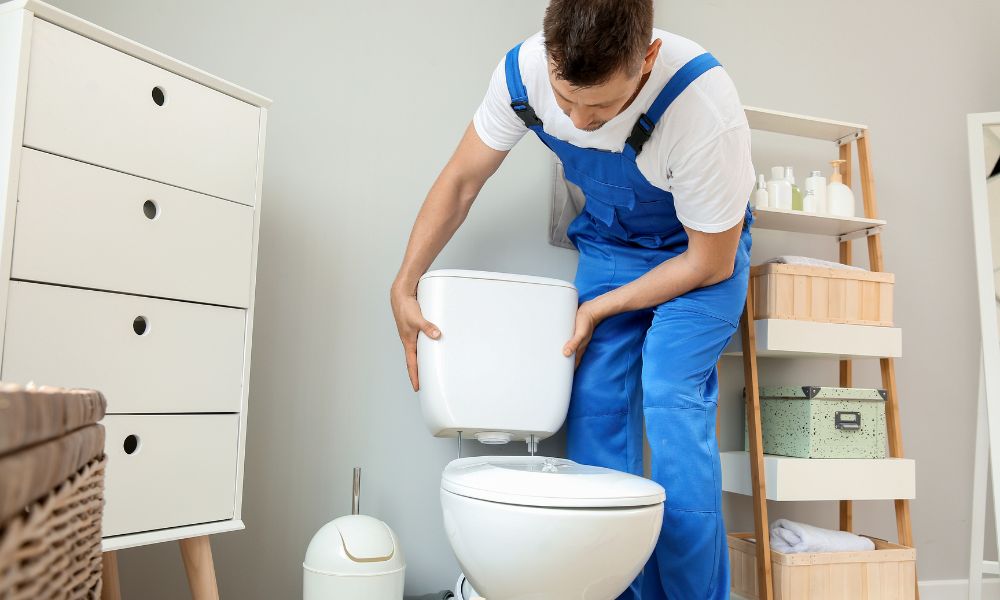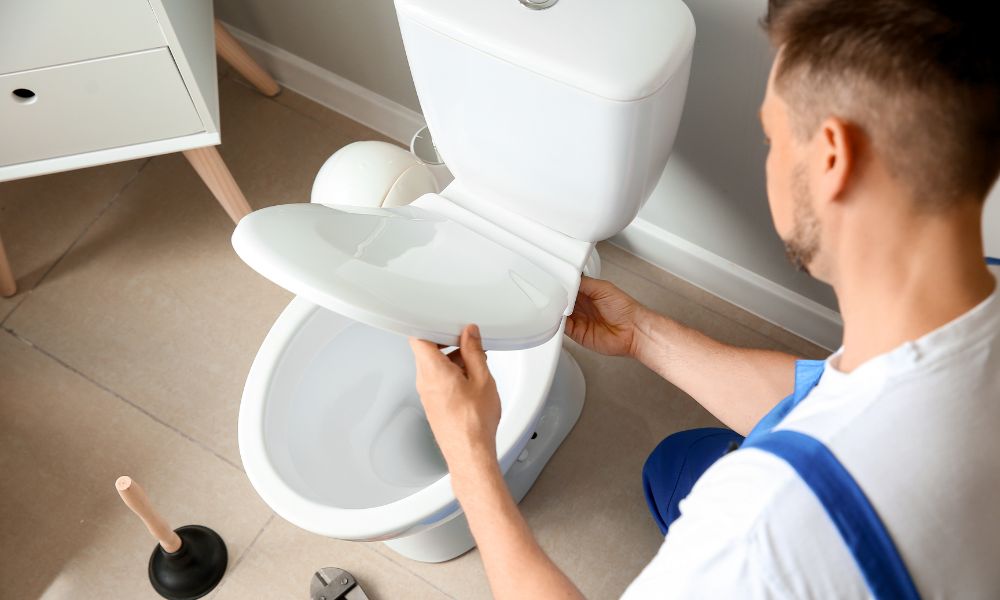
Installing a new toilet isn’t as complicated as you might think, with the right tools and guidance, it’s a project you can tackle on your own.
There are two possibilities when you need to install a new toilet:
- Replacing the old one with an upgraded model
- Installing from scratch in a new bathroom
This blog article will instruct you on how to best install a close coupled toilet, arguably the most commonly used toilet.
- Things to Consider Before Installing a New Toilet
- Tools You’ll Need to Install a New Toilet
- How to Remove a Toilet
- How to Install a New Toilet
- Why Would You Need a New Toilet?
Navigate to any section of this post by clicking on the links above.
Things to Consider Before Installing a New Toilet
Before getting started on the work of installing a new toilet, there are things you need to consider.
It’s important to make sure you can isolate the water supply and ensure the soil pipe doesn’t need adjusting. If either of these things does require adjustment, we advise contacting a plumber before getting started.
The next thing to consider is the floor. The floor is an important factor because even a slight change to the floor will require changes to both your bathroom and toilet.
If you are looking to change the floor height, we recommend using an ‘offset’ pan tube and pipe connector. If your adjustments are on a slightly larger scale, again, professional advice may be necessary.
If your bathroom floor isn’t even, we advise using a silicon sealant to level it out. Alternatively, you can use wooden or plastic wedges to do this. However, if wedges are used, remember to silicon them down for safety reasons.
The direction of your toilet’s soil pipe is another important factor. When the soil pipe comes through the floor rather than the wall, a 90-degree bowl connector may be required. Again, as bathroom experts, we advise consulting with a plumber for a professional recommendation.
If you’re looking to fit a high-level or low-level toilet, you must own strong fixing points to support the cistern weight. For outside walls, this isn’t a problem, but for hollow walls, cisterns fittings should go into timber studs.
In certain situations, you may have to cut the plasterboard away and replace it with horizontal wooden support.
Tools You’ll Need to Install a New Toilet
Having the following tools handy will simplify the task of installing a new toilet.
Tools Needed to Replace an Old Toilet:
- Bucket
- Old towel
- Sponge
- Screwdriver
- Adjustable wrench
- Rubber gloves
- Silicone
- Adjustable pliers
- Putty knife
To install a toilet from scratch, you’ll need more tools:
- Flexible hose
- Spirit level
- Tape measure
- Pencil
- Pipe cutter or hacksaw
- Hammer
- Drill
- Pipe wrench
- Box spanner
How to Remove a Toilet

In order to install a new toilet, you have to first take the old one out. Follow the steps below to quickly remove the old toilet:
- Turn off the water supply at the shut-off valve
- Flush the toilet to get rid of as much water as possible out of the cistern
- Using a sponge, suck up the remaining water out of the pan
- With a putty knife, cut the caulk holding the toilet to the floor. Next, unscrew the screws at the base of the pan
- Unscrew the retaining screws that connect the system to the wall
- With both disconnected, ease the bowl and cistern away from the wall, allowing the waste pipe to disengage from the toilet connector
How to Install a New Toilet

Follow the steps below to install a new toilet:
- When installing a new toilet, the bulk of the work involves constructing the cistern, so make sure you have every component needed to do this
- The brand of toilet you purchase will affect the instructions given to construct it. Follow the manufacturer’s instructions on assembling the inner part of the cistern
- Where instructed, tighten screws properly. This does not mean over-tightening them, so if possible, tighten them by hand
- The majority of close-coupled toilets will have cisterns that need bolts to connect them to the pan. Make sure you screw these bolts on in the correct order
- Be sure the large close-couple washer is positioned at the top of the pan, and then position the cistern in place
- Insert a pan tube into the soil pipe, making sure it fits tight, with no gaps or spare room
- Then, align the toilet next to the soil pipe, making sure the pipes are aligned. If they are not, you may need an off-set pan tube to connect them
- Carefully place the toilet on to the back wall, ensuring the waste fits perfectly into the toilet connector. Make sure the toilet goes right into the connector collar
- Ensure the cistern is level by using a spirit level. Using a pen or pencil, mark the fixing holes at the back of the cistern
- Make sure the toilet pan is level by using a spirit level. Using a pen or pencil, mark off the fixing holes
- Mark around the edge of the toilet pan using a pencil. This will indicate the exact position of the pan once it comes to the final fitting
- Remove the toilet from the wall. Navigate where to drill the cistern fixing holes using the marks on the wall. Pick and put in relevant plugs according to the wall surface
- Drill holes for the pan using the marks previously pencilled. Select and insert wall plugs where appropriate
- Using the marked pencil lines as a reference point, apply silicone sealant to where the toilet will be positioned
- Place the toilet onto the sealant. Then screw the cistern in place. Remember not to over-tighten
- Position the screws at the bottom of the toilet and then secure the pan to the floor. Again, use all the washers provided and remember not to over tighten
- Reconnect the water supply. It might be useful to use a flexible connector depending on the position of the toilet pipe
- Turn the water supply back on and check all aspects of the new toilet to make sure it’s leak-free
- Secure the seat by inserting bolts through the pan and add a washer and nut. Adjust as necessary to fit correctly to the toilet bowl shape
- Silicone all the way around the base of the toilet pan and smooth off with a damp sponge for a neat finish
FAQs
Why Would You Need a New Toilet?
A stained or scratched toilet can be an eyesore. But there are other compelling reasons to replace an old toilet.
1. Leaks
Not all leaks are obvious. For instance, a minor leak in the toilet’s tank or bowl can go unnoticed for months, causing damage to the bathroom floor or subfloor.
Once a leak is detected, if it’s not fixed immediately, it can cause serious damage. And if the bathroom is upstairs, the water seepage can damage the walls of the room below.
When dealing with an older toilet past its prime, it’s more cost-effective to opt for a new toilet than to detect and fix leaks. In addition to floor and wall damage, leaks also result in water wastage, driving up your utility bill.
2. Frequent Clogging
Human waste and toilet paper are the only items that can be flushed down a toilet. It’s quite possible that children may inadvertently flush toys or other objects.
But if you are forced to use a toilet plunger once too often and cannot identify any preventable human activity causing the frequent clogging, the toilet is clearly a problem.
An older toilet will need more than one flush. It’s also susceptible to random clogs, especially when non-flushable items are disposed of in the toilet.
You’ll need a new toilet once you confirm the clog isn’t due to a fault in the drain pipe.
3. Broken Components
The toilet tank mechanism isn’t complex. But it does have many different working parts, such as:
- Flush valve
- Flush valve chain
- Tank lever
- Float arm
- Float ball
- Inlet valve
- Overflow tube
- Filler tube
- Inlet tube
- Bowl refill tube
- Bowl to floor seal
- Tank to bowl gasket
While every component may not need to be replaced at the same time, the cost of components and the time required to replace them may simply not be worthwhile.
If your toilet tank breaks down every other week, it’s time to replace your toilet.
4. Appearance/Bathroom Remodelling
It’s possible that your old toilet may not complement the current colour scheme of your bathroom. Worse still, it may be ruining your bathroom aesthetic.
Toilets with colours like pale blues, greys, peach, and teal were popular choices decades ago. But today, these colours may make your bathroom look hopelessly dated.
Modern toilets come in an assortment of colours besides common colours such as white or black. But remember, designer colour toilets carry higher price tags.
Also, if you’re remodelling your bathroom, it’s the best time to change the toilet. A new toilet can accentuate the design of your bathroom.
5. To Save Water and Energy
In the average UK home, toilet flushing accounts for approximately a third of total water usage. A person probably flushes down the toilet as much water in one day as they drink in a whole month.
Old standard toilets use more water compared to the latest dual flush toilets. The newer model toilets also have a larger trap-way to minimise clogging.
Energy-efficient toilets rely on water velocity to push down waste instead of water volume, resulting in a 20 to 60% reduction in toilet water usage.
Switching to a new energy-efficient toilet can reduce the water consumption of an average family by up to 49,210 litres per year and save up to £87.3 a year on their utility bills.
How Much Does It Cost to Install a Toilet?
Since a toilet is heavy and awkwardly shaped, manoeuvring it into the right place and ensuring it isn’t damaged during installation can be a challenge.
Hiring a professional to install a toilet will eliminate the possibility of dropping it or sustaining an injury during installation.
The standard toilet installation cost can vary between £180 and £700, depending on the location of your residence, the type of toilet, and the need for any additional plumbing work. Removing the existing toilet will also cost you extra.
Some toilets can be extremely complex to install due to space constraints. This will also mean higher labour costs.
How Long Does It Take to Install a Toilet?
Installing a simple one-piece toilet can be finished in as quickly as two hours. However, the installation of a wall-mounted toilet with a concealed cistern is complex and can take a whole day.
Installing a toilet can take much longer than expected if there are space constraints or removing the existing toilet is delayed due to rusted nuts and bolts.
Speak to your plumber about their hourly rate (it could be anywhere between £40 and £60). You could end up spending an extra hundred pounds on the project.
Shop Durable Bathroom Toilets
At Bathroom City, we have a wide variety of high-quality toilets, perfect for every style of bathroom and en-suite. For more information about the toilets we provide, call today on 0121 753 0700 or visit our showroom in Tyseley – opening times are Monday to Friday 9:00 to 5:30 pm, Saturday 9:00 to 5:30 pm, and Sunday 10:00 to 16:30 pm.
Other related articles that you might also be interested: